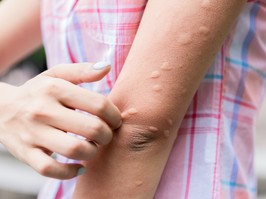“we went straight to the ‘scratch test’ to figure out why she was so itchy,” says colleen. “she was positive for 26 out of 90 allergens, which included environmental, indoors and foods.”
whenever layla came into contact with springtime grasses and pollens, her eyes would run and she would scratch her side, stomach and ears. in fact, she scratched her ear so much she broke the cartilage and had to have it removed.
“it was very hard to see her scratching so much and not being able to make it stop,” says colleen. “it broke my heart when she’d hurt herself and cry out from all the scratching.”
some breeds are more susceptible to allergies
veterinarian dr. jangi bajwa, a board certified veterinary dermatologist at the
vetderm clinic in surrey, b.c., says anywhere from 10 to 20 per cent of dogs suffer from seasonal (usually referred to as environmental) allergies. and while they aren’t restricted to certain breeds, there are some that are prone, including colleen and doug’s sheltie/poodle cross (chinese crested’s are more sensitive to wool), german shepherds, labrador retrievers, golden retrievers, pugs, french bulldogs, pit bulls and boston terriers.
cats can be afflicted as well, says bajwa. when a sensitive cat inhales or comes into direct contact with pollen, its immune system overreacts, manifesting in inflammation of the skin and ears, which can lead to itchiness, redness or lesions. like dogs, signs of environmental allergies include scratching the skin and ears, paw chewing, head shaking, excessive licking, hair pulling, watery eyes and runny nose, all of which can lead to secondary infections, compounding the agony.
 6 minute read
6 minute read









